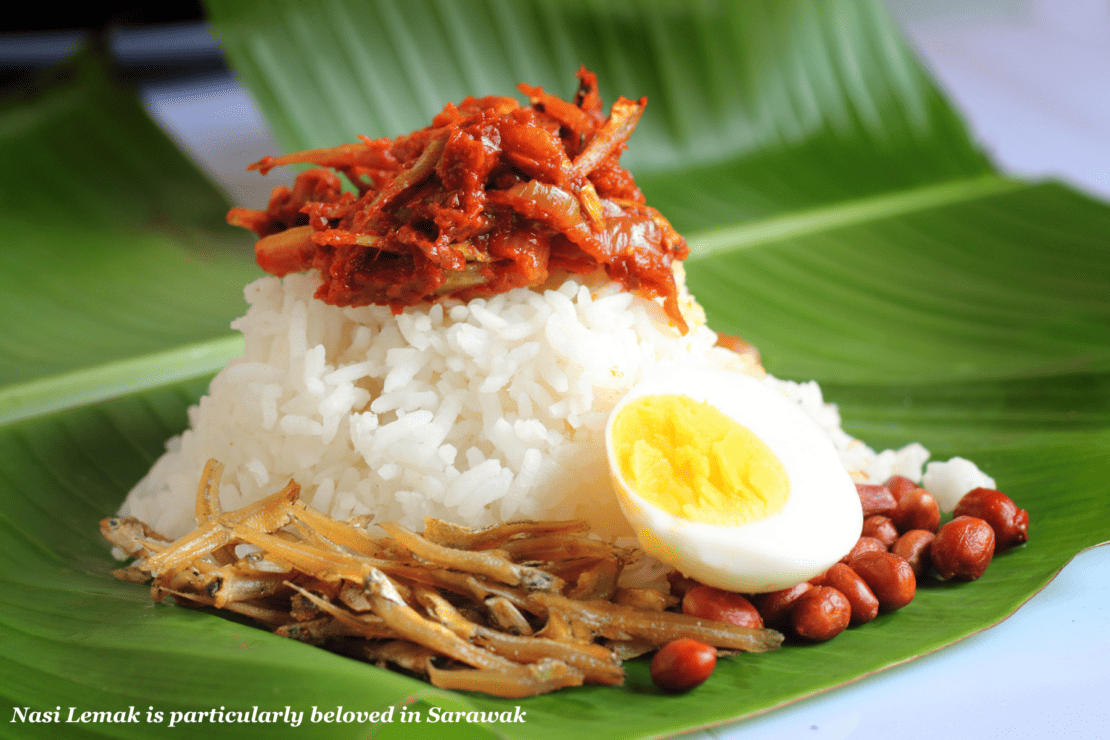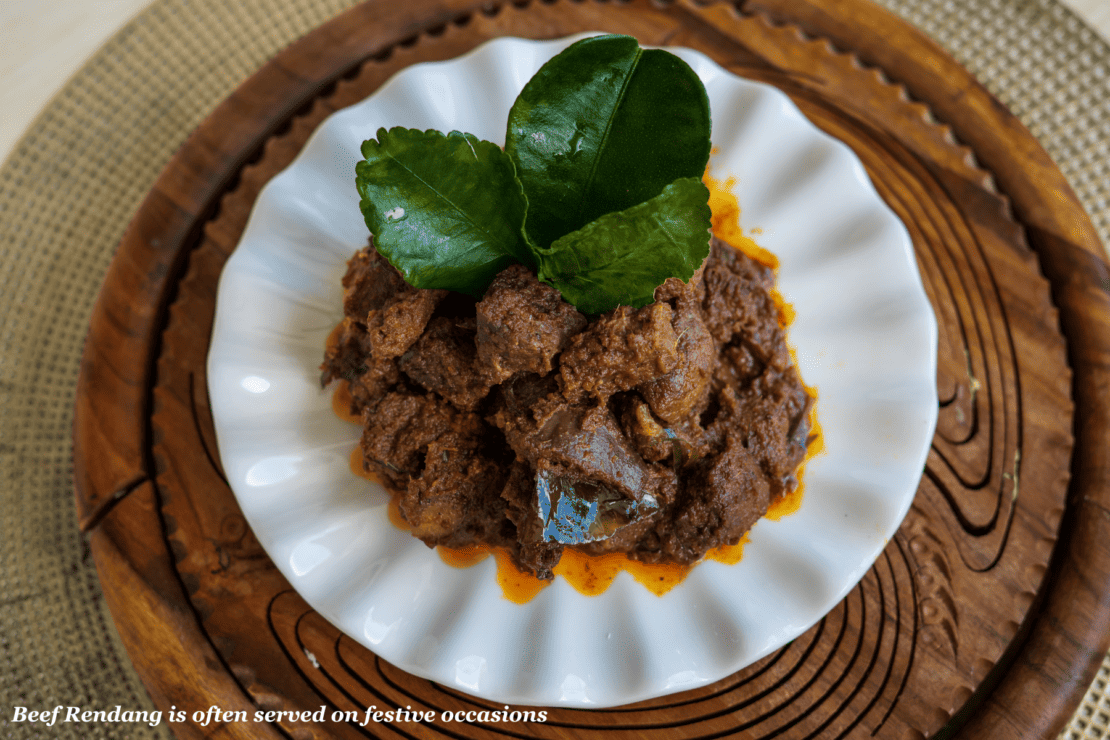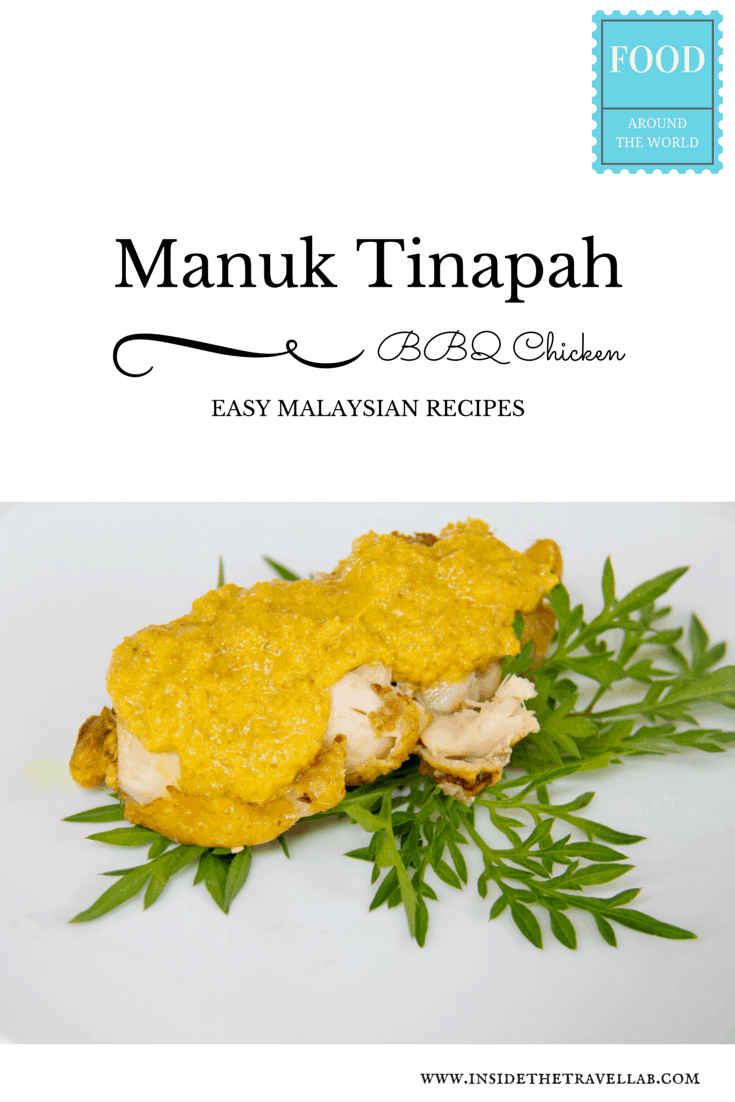Welcome to our Borneo food guide, bursting with flavour and tradition and including some easy Borneo recipes you can try at home. Lazat!
Your Borneo Food Guide
An Overview
My introduction to Borneo food arrived to the soundtrack of thunderous monsoon rain. I studied at the Mango Garden Restaurant near Kota Kinabalu and journeyed across Malaysian Borneo, from street market to food hall, grand hotel to lightbulb-lit lounger.
Malaysian Borneo itself is a mix of Chinese, Malay and indigenous peoples and as you’d expect, the food is too. It’s typically light and healthy, bursting with lemongrass, shrimp paste and coconut and plenty of fresh river fish. In fact, it’s one of my favourite cuisines in southeast Asia.
Where is Borneo?
Borneo is the third largest island in the world, found in the southwest Pacific and divided between Indonesia, Malaysia and Brunei.
Malaysian Borneo consists of Sabah and Sarawak, which, let’s face it, are fantastic sounding names, with beaches, cities, and mangrove swamps galore.
Expect plenty of grilled fish and barbecued prawns, along with rice and noodles, and locally grown vegetables. The stand out characters include rambatan, with its scarlet spiked skin and soft white inside, and banbagan, a kind of savoury mango with a rough, brown skin.
Ready to delve into this Borneo food guide? Let’s go.
Famous Dishes that Give a Taste of Borneo
Whether you’re at a street food stop, a high end restaurant or one of Borneo’s food chains, look out for the following:
Soto Banjar
Soto Banjar is a cherished soup from the Borneo Kalimantan cuisine, brimming with succulent broth, meat, and vegetables. With its key ingredients being chicken, potato pancakes, and rice cakes, it’s a comforting dish enjoyed in various contexts.
From bustling street food stalls to family gatherings, it’s a popular choice throughout Borneo, especially in South Kalimantan.

Nasi Lemak
Nasi Lemak, a fragrant rice dish cooked in coconut milk and pandan leaves, has a rich history across Malaysia and Indonesia. Known for its creamy texture and aromatic flavour it’s traditionally served with hard-boiled eggs, crispy anchovies, and spicy sambal.
A versatile dish, it is enjoyed at any time of the day. It’s particularly beloved in Sarawak, where locals have added their unique twist to this classic recipe.
Sarawak Laksa
Hailing from the state of Sarawak, Sarawak Laksa is an enticing noodle soup that blends the heat of sambal with the richness of coconut milk. Its broth, enveloping prawns, chicken, and egg noodles is a celebration of flavours.
Traditionally served for breakfast or lunch, it’s a must-try for anyone exploring Sarawak’s culinary scene. Its popularity extends across Malaysian Borneo, but its roots remain firmly in Sarawak.

Beef Rendang
Beef Rendang, originating from the Minangkabau ethnic group of Indonesia, is a slow-cooked beef delicacy simmered in coconut milk and a medley of spices. The result is tender beef that melts in your mouth, paired with a sauce that’s a symphony of sweet, spicy, and savoury notes.
Often served during festive occasions, you’ll find it all across Borneo and beyond. However, it’s particularly popular in West Kalimantan, where it’s a staple at local food markets.
Kolo Mee
Kolo Mee takes its roots from the Hakka Chinese community. Arriving in Sarawak in the 1920s, this dry noodle dish, akin to Cantonese ‘wantan mee’, quickly gained popularity.
Today, it’s a favoured dish across Borneo, particularly in Kuching. The secret of this Chinese food dish lies in its simplicity – noodles tossed in aromatic garlic oil, garnished with minced pork, and served with a side of clear soup.

Curry Puff
Curry Puff, an irresistible pastry snack, is a delightful blend of culinary worlds. Originating from the Indian samosa, it was adapted to local Malaysian tastes and quickly spread across the region.
Encased in flaky pastry, a curry puff contains a spicy potato and chicken filling. It’s a common sight at roadside stalls, bakeries, and even high-end restaurants, reflecting its universal popularity as a snack for on the go.
Tuhau
Derived from a ginger-like plant found in the highlands, Tuhau is typically served as a pickled salad. Its unique, pungent aroma and refreshing crunch make it a beloved condiment, especially in the Kadazandusun community. A taste of Tuhau is a taste of the wild heart of Borneo itself.

Ambuyat
Ambuyat has its history rooted in World War II when rice was scarce. This sticky, starchy dish is made from the interior trunk of the sago palm, showcasing Borneo’s innovative use of its abundant natural resources.
Served with a variety of tangy dips, it’s a communal meal, bringing people together around a shared pot, particularly in Brunei and parts of Sarawak.
Ais Kacang
This refreshing dessert traces its roots to the Middle Ages in the Middle East when sherbet was becoming popular.
It’s a delightful mix of shaved ice, red beans, and a variety of other ingredients which have made their way into the dish over time. This treat offers respite from Borneo’s tropical heat and it’s particularly popular in the bustling streets of Kota Kinabalu.

Grilled Fish and Barbecued Prawns
Borneo’s coastal areas feast on grilled fish and barbecued prawns. A tradition passed down through generations, the seafood is marinated in a blend of local spices before being cooked over charcoal. The aroma wafts through the night markets of Sandakan, drawing locals and tourists alike.
Sarawak Layer Cake
Sarawak Layer Cake, also known as ‘kek lapis’ is meticulously prepared with multiple thin layers, each representing a unique flavour. This cake is an indispensable dish at festive occasions and is most prominent in the cultural heartland of Kuching.
Mee Sua
A comforting symbol of longevity, Mee Sua is a type of thin, salted wheat noodle that originated in Fujian, China. Now a popular dish in Borneo, these delicate threads are typically served in a richly flavoured chicken broth, garnished with mushrooms and hard-boiled eggs.
Celebrations like birthdays and Chinese New Year are incomplete without this heartwarming noodle soup. It’s especially popular in the Chinese communities of Kuching and Miri.

Hinava Sada
A Kadazan-Dusun delicacy, Hinava Sada is made with fresh raw fish cured in lime juice, which is then mixed with local herbs like ginger, chilli, and bambangan seed. This dish is a star at the annual Kaamatan harvest festival, especially in the rural districts of Sabah.
And you can find the recipe for this traditional Borneo dish towards the end of this article…
Linopot
Linopot reflects the ingenuity of the native Dusun and Murut tribes of Sabah. This humble dish is essentially rice wrapped in leaves, often from the turmeric plant. The leaves impart a subtle aroma to the rice, which is typically served with local vegetables and chicken, beef, or wild game. Linopot is an integral part of festive feasts and communal meals in the rural areas of Sabah.
Manok Pansoh
An emblem of Sarawak’s Iban community, Manok Pansoh is chicken cooked in a bamboo tube or bamboo shoot, similar to bamboo chicken. The unique twist here is the addition of tapioca leaves, lemongrass, and torch ginger, resulting in an aromatic, herb-infused dish.
Traditionally savoured during Gawai Dayak, the harvest festival, it’s a culinary experience that connects diners to the rich biodiversity of Sarawak. This dish is widely enjoyed in the Iban-dominated areas of Borneo.

Chicken Rice
Chicken rice, or Nasi Ayam, is a beloved dish, especially in the bustling streets of Sabah. Tender, flavourful chicken is served alongside aromatic rice cooked in chicken stock, with a side of chilli and ginger sauce to add a spicy kick. It’s one of the best comfort foods you can find in Borneo.
Rice Wine
Borneo’s rice wine, known locally as Tuak, is a traditional alcoholic beverage with roots in the indigenous communities of the island. The recipe for this rice-based spirit, primarily made from glutinous rice and yeast, has been passed down through generations.
While it’s a common sight at festive celebrations and rituals across Borneo, it holds a special place in Sarawak, where it’s often brewed at home.

Taking a Cooking Class in Borneo near the Upside Down House
The name of the game was the “Basic Sabah Ethnic Cooking Class” run at the Mango Garden Restaurant (right next to the rather bizarre Upside Down House. A story for another day perhaps…)
But how basic was basic? In other words, was it going to be basic enough for the likes of me?
Food so far in Malaysia had tasted so fresh and so delicately spiced. The clear soups and sauces disguised the strength of the flavours and carried a secret I thought I’d never manage to learn. Back home, soups come thick and chunky, with taste indicated by hue, the brighter the better.
I bundled my camera and notebook beneath the monsoon skies and scurried into the class, distracted by splatters of roadside mud and the thunder of rain on tarpaulin.
Taking the Basic Sabah Ethnic Cooking Class
Oh, cover me in eggs and flour and bake me in a banana leaf for 40 minutes, it was. Not only did the whole plan come together but (bar an ingredient or two) this menu did actually look like something I’d be able to do back home.
Step aside Jamie Oliver. I’m coming home ready to impress.
Easy Borneo Recipes to Try at Home

Manuk Tinapah – BBQ Chicken in Herbs
Unlike the other recipes, this one is generally reserved for high days and holidays. The rich canary yellow sauce brings a splash of colour to the plate and locals use it to dazzle at weddings or to celebrate the end of the holy month of Ramadan. Manuk means chicken and Tinapah means BBQ in the local Bajau dialogues but, well, you know, Manuk Tinapah sounds cooler than plain old barbecued chicken.
Ingredients
200g boneless chicken, 30g garlic, 30g ginger, 40g mashed shallots, 30g galangal (root that’s similar to ginger,) 30g lemongrass, 15g turmeric, 20g saw leaves (hm, may need to resort to rocket in the UK,) 50ml coconut milk, 20ml cooking oil. Sugar and salt to taste.
Recipe
- Pound the garlic, ginger, shallots, galangal, lemongrass and turmeric together to form a chunky paste.
- In a bowl mix in all the other ingredients, season to taste and marinate for around 10 minutes.
- Roll the chicken and tie with string. Cook in the coconut milk until half cooked (slightly pink when sliced.)
- Remove the chicken and put aside for grilling.
- Turn up the heat to medium high and reduce the coconut gravy to form a sauce.
- Pour the oil into a frying pan and cook the chicken until slightly browned and burned.
- Slice the chicken, set it on the salad leaves and then audaciously drizzle some sauce all over it and into a fancy spiral on the plate.
- Eat and enjoy (with rice if you need a carb hit.)
Daeng Masak Timbul
The tradition behind this recipe involves stealth cooking on a boat – either from pirates evading capture or hardworking fishermen struggling to get by. Either way, this Ubian delicacy from northern Sabah is super fast, ultra fresh and with the low fat combo of lean protein and mixed veg, it’s ridiculously good for you.
It even looks good when artfully arranged.
200g Tuna 20g, Garlic 30g, Ginger 30g, Onion 20g, Turmeric 20g, Chilli 30g, Tomatoes 30g, Lemongrass 20g, Lemon Basil Leaves 10g, Dried Carambola (starfruit to the rest of us…) Salt to taste
Recipe
- Clean and cut the fish into large pieces (about the size of a deck of cards.)
- Slice the garlic, ginger, onions and turmeric
- Pound the lemongrass then cut the chilli and tomato into wedges
- Mix everything except together in a pot of water and bring to the boil (everything except for the fish and lemon basil that is.)
- Once the water is boiling, add the fish and lemon basil and boil until the fish is cooked through.
- Pour into a bowl and garnish.
- Serve hot and enjoy

Hinava Sada
Hinava sada has quite a ceviche vibe (the fish is “cooked” by the citrus juices rather than by heat from over a fire.)
I love, love, love this kind of combination but if you’re at all uneasy at the sight or taste of “raw” fish then perhaps this isn’t for you. I’d urge you to give it a try, though, and you can rustle it up as either a starter or side dish or even (served with enough salad) as a summer main course.
If you’re short on time, this can also be prepared the day before and left in the fridge ready to go.
200g Fresh Tuna Fillet, 67g Bitter Gourd, 17g Ginger, 34g Shallots, Red Chilli, 42ml Lime Juice. Salt to taste.
Recipe
- Clean and finely slice the tuna fillet then marinate it with lime juice and salt.
- Slice the bitter gourd, ginger, shallots and chillies into thin, thin strips
- Mix everything together in a bowl and leave for at least 10 minutes.
- Toss well then serve.
- That’s it! Ta da!
So, there you go. Three really easy Malaysian Recipes, recipes so simple that even I could make them look and taste good.
Have a go yourselves and let me know how you got on!
Cheers for now,

Disclosure: I visited the Mango Garden Restaurant as part of a project with iAmbassador, Sabah Tourism and Royal Brunei Airlines. As ever, as always, all words and thoughts and tastes and cooking experiences my own. Otherwise, there’s just no point. The pics are my own too and what’s more I made all the food myself! How about that?!
More About Food in Asia
Now you’ve indulged your taste buds through this Borneo food guide, travel further into south Asia to try these out.


I did this exact same cooking day at the Mango garden restaurant! The chef was amazing and the recipes so delicious and fresh!
Aha! Small world! I agree – the chef was amazing. Your comment has just reminded me how I promised myself I would cook this when I got home…Need to get cooking!